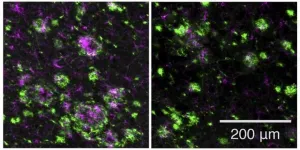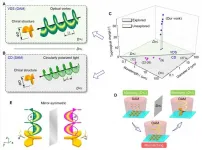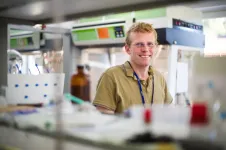(Press-News.org) CHAMPAIGN, Ill. -- The liver has a rare superpower among body organs - the ability to regenerate, even if 70% of its mass is removed. It also keeps up its metabolic and toxin-removing work during the process of regeneration, thanks to a subset of cells that expand their workload while the rest focus on multiplication, a new study in mice found.
Furthermore, the cells of the liver communicate with each other to coordinate regeneration activity, which progresses from the center to the periphery of the missing liver lobes, researchers at the University of Illinois Urbana-Champaign said.
"It's remarkable how we still don't understand many aspects of liver regeneration," said Illinois biochemistry professor Auinash Kalsotra, who led the study published in the journal Genome Research. "After a portion is surgically removed, the rest quickly starts regenerating. Within weeks, the liver is back to its original size and mass - no more, no less."
Previous work from Kalsotra's group found that, during regeneration, mature liver cells - normally stable and slow to divide - revert to a more pliable neonatal state. This allows them to divide quickly but causes them to lose their metabolic function. Questions remained of how the liver maintained mature metabolic function while its cells reverted to an immature state, and how the cells know when to stop proliferating.
"Whether regeneration follows a surgical resection of the liver, or is due to an underlying liver disease or chronic liver injury from alcohol or toxins, the liver has to keep functioning. This study revealed a division of labor within the liver that allowed it to address the body's metabolic needs while regenerating," said Kalsotra, a member of the Carl R.. Woese Institute for Genomic Biology at Illinois.
The researchers used a technique that allowed them to individually sequence the RNA of each cell in regenerating mouse livers, revealing its activity. They studied mouse livers at various points during the regeneration process to map how regeneration progressed, as well as where metabolic function was maintained.
They identified a specific class of cells that do not proliferate, but instead ramp up their metabolic function, taking on a greater workload. These were localized near blood vessels, said graduate students Ullas Chembazhi and Sushant Bangru, the co-first authors of the paper.
Meanwhile, the regenerating cells multiplied in a coordinated manner, starting from the middle regions and progressing outward toward the liver's periphery - contrary to prevailing theories in the field that proliferation begins near the veins.
"We found it's actually the midlobular cells that are the most prolific, and that made perfect sense to us because we had just found that there are certain cells that keep and actually turn up their metabolic profiles. These metabolic cells live near the blood vessels, so it makes sense that those cells should stay put, and the interior cells are the ones that divide," Kalsotra said.
The researchers found that the regeneration and metabolic activities were coordinated through extensive cell-to-cell communication. The communication dramatically increased after part of the liver was removed, but by the time regeneration slowed and stopped, the signaling had gone back down toward base levels.
In studying the coordination between cells, they also found a possible explanation for how the regeneration process regulates itself so the liver stops growing when it reaches its original size. Mature liver cells had an abundance of receptors on their surfaces that were activated by molecules their neighboring cells released after surgery, triggering the cells to become neonatal-like and divide. During the proliferation process, however, the cells stopped expressing the receptors, allowing them to return to a mature state when division was complete.
"Normally, the cells are ready to receive these signals. But once they do and are regenerating, they don't need to keep receiving those signals because they would get into an endless run of proliferation. So they stop expressing these receptors. Once the triggers are gone and regeneration is complete, the cells start to make more of the receptors so they are ready if there's an injury again," Kalsotra said.
INFORMATION:
The National Institutes of Health, the Muscular Dystrophy Association, the Cancer Center at Illinois and the Center for Advanced Study at Illinois supported this work.
Editor's notes: To reach Auinash Kalsotra, call 217-300-7654; email kalsotra@illinois.edu. The paper "Cellular plasticity balances the metabolic and proliferation dynamics of a regenerating liver" is available online.
DOI: 10.1101/gr.267013.120
Researchers at the University of California San Diego School of Medicine and Massachusetts General Hospital have identified a new drug that could prevent Alzheimer's disease by modulating, rather than inhibiting, a key enzyme involved in forming amyloid plaques in the brain. The study, which will be published March 2 in the Journal of Experimental Medicine (JEM), demonstrates that the drug is safe and effective in rodents and monkeys, paving the way for future clinical trials in humans.
A key pathological hallmark of Alzheimer's disease involves the formation of amyloid plaques composed of small protein fragments known as amyloid-β (Aβ) peptides. These peptides are generated ...
OAK BROOK, Ill. - Attendance at regular mammography screening substantially reduces the risk of dying from breast cancer, according to a large study of over half a million women, published in the journal Radiology. Researchers said women who skip even one scheduled mammography screening before a breast cancer diagnosis face a significantly higher risk of dying from the cancer.
Breast cancer screening with mammography has helped reduce disease-related deaths by enabling detection of cancer at earlier, more treatable stages. Despite mammography's well-established ...
Recently, research group led by Professor CHENG Lin from School of Microelectronics, University of science and technology of China has made significant achievements in the field of fully integrated isolated power chip design. They proposed a chip based on glass fan-out wafer-level package (FOWLP), achieving 46.5% peak transformation efficiency and 50mW/mm2 power density.
Compared with the traditional isolated power supply chip, this new design interconnects the receiving and transmitting chips through the micro transformer made of the rewiring layer, showing no need of additional transformer chips. In this way, it lowered the need ...
The pandemic has impacted significantly on people who suffer chronic pain. A study performed by the eHealth Lab, a research group affiliated with the Faculty of Health Sciences and the Universitat Oberta de Catalunya's eHealth Center, has shown that 70% of the people with chronic pain have seen their condition worsen in terms of severity, frequency of episodes and interference in their daily activities.
A total of 502 patients took part in the study; 88% were women aged between 30 and 59, with long-duration chronic pain (mean duration, 7 years). Most participants (87.6%) had pain in more than one point; the most frequent locations were the abdomen, lower back and neck. The participants answered online surveys, designed in accordance with ...
Organometallic reagents are essential tools in synthetic chemistry. They work even better and more effectively in combination with alkali alkoxides. The exact nature of this effect has never been well understood. A team based in Switzerland has now performed a detailed study of the mechanism of reaction of aryl bromides with organo-magnesium reagents and lithium alkoxides. As reported in the journal Angewandte Chemie, a complex equilibrium of bimetallic intermediates plays a key role.
Substituted aromatic ring systems are an important class of building block for the synthesis of many products, including pharmaceuticals, agrochemicals, and ...
Recently, the Laboratory of Micro and Nano Engineering, School of Engineering Science, University of Science and Technology of China (USTC) has made important progress in the field of structural chirality detection research using vortex light and found that photon orbital angular momentum can efficiently detect the optical chiral signal of structures.
The achievement was published in an international well-known journal PNAS.
Chiral structures are widely found in nature, such as DNA double helix structures, plant tendrils and shells. In addition to observing the geometry of objects, their chirality can also be distinguished by the interaction of light with matter. For example, the detection of circular ...
Aqueous free-radical precipitation polymerization is one of the most useful methods to prepare the uniformly sized hydrogel microspheres (microgels), and an understanding of the polymerization mechanism is crucial to control the structure or physicochemical properties of microgels. However, the details of the mechanism of precipitation polymerization remain unclear.
Thus, first author Yuichiro Nishizawa, Prof. Daisuke Suzuki of the Graduate School of Textile Science & Technology, Shinshu University and Prof. Takayuki Uchihashi of Nagoya University set out to clarify the formation mechanism of microgels during precipitation polymerization by evaluating structural evolution and thermoresponsiveness of developing microgels during ...
The study examined the gender and affiliations of 1051 top-authors, those scientists with the most publications in 13 leading ecology and conservation journals. The results show that women and the Global South are barely represented on this list. "The overall list of top authors included only 11% women, while 75% of the articles were related to just five countries in the Global North," says Bea Maas, lead author from the University of Vienna. "This massive imbalance in scientific authorship is extremely concerning, especially in the field of ecology and conservation, ...
The formation of double bonds between two carbon atoms (C=C) is of central significance in natural organisms. The vast majority of natural substances therefore contain one or more of these double bonds. Compounds with C=C double bonds, the alkenes or olefins, also play a prominent role in the organic chemical industry. A great many chemical processes have therefore been developed over the years to control the formation of C=C bonds.
One such process, olefin metathesis, has received particular attention over the last few decades and the 2005 Nobel Prize for Chemistry was awarded in recognition of its significance.
Despite the many ...
A technological and biological development that is unprecedented in Israel and the world has been achieved at Tel Aviv University. For the first time, the ear of a dead locust has been connected to a robot that receives the ear's electrical signals and responds accordingly. The result is extraordinary: When the researchers clap once, the locust's ear hears the sound and the robot moves forward; when the researchers clap twice, the robot moves backwards.
The interdisciplinary study was led by Idan Fishel, a joint master student under the joint supervision of Dr. Ben M. Maoz of the Iby and Aladar Fleischman ...



